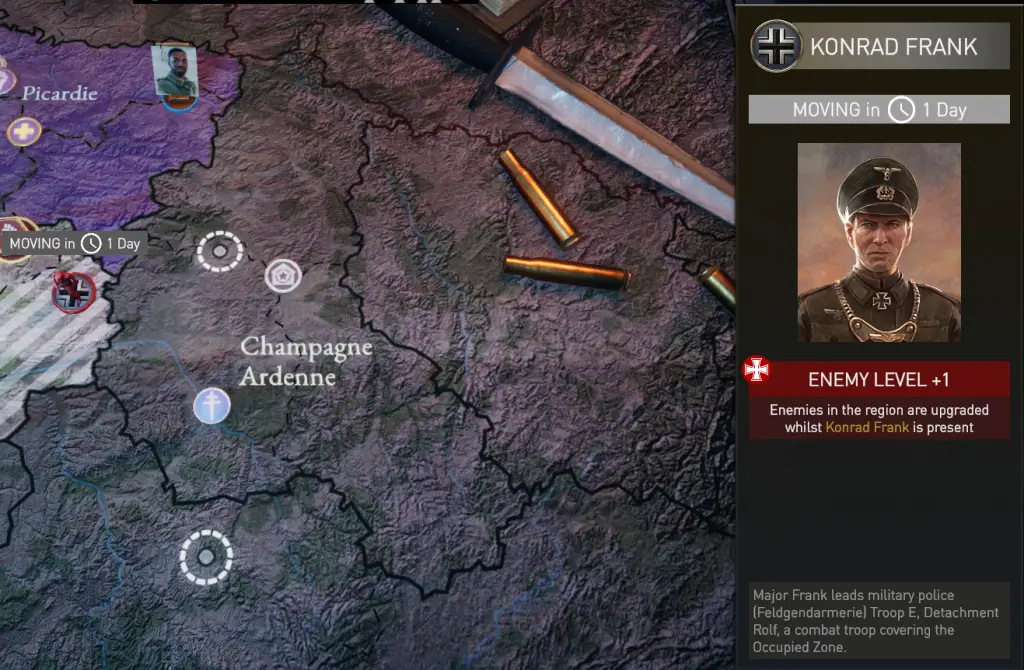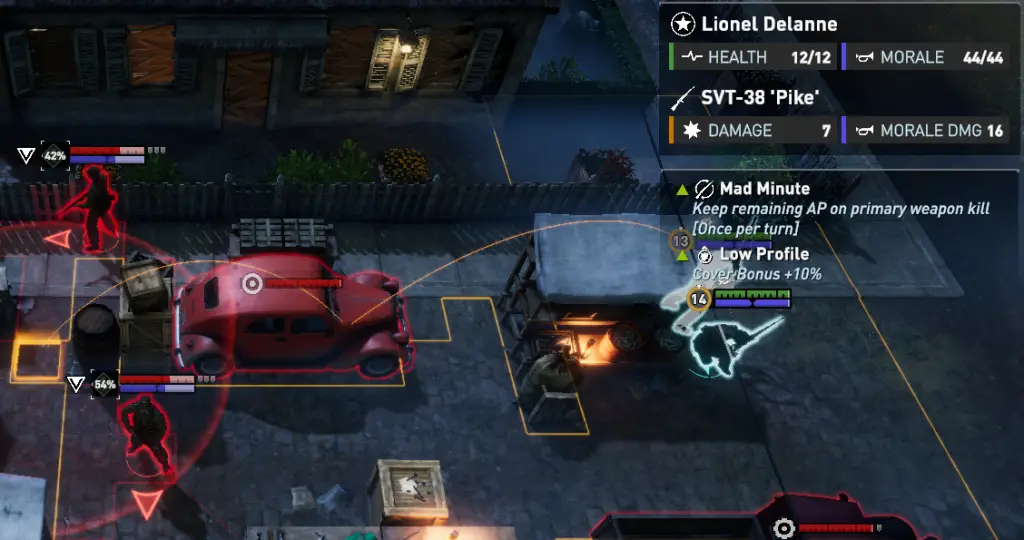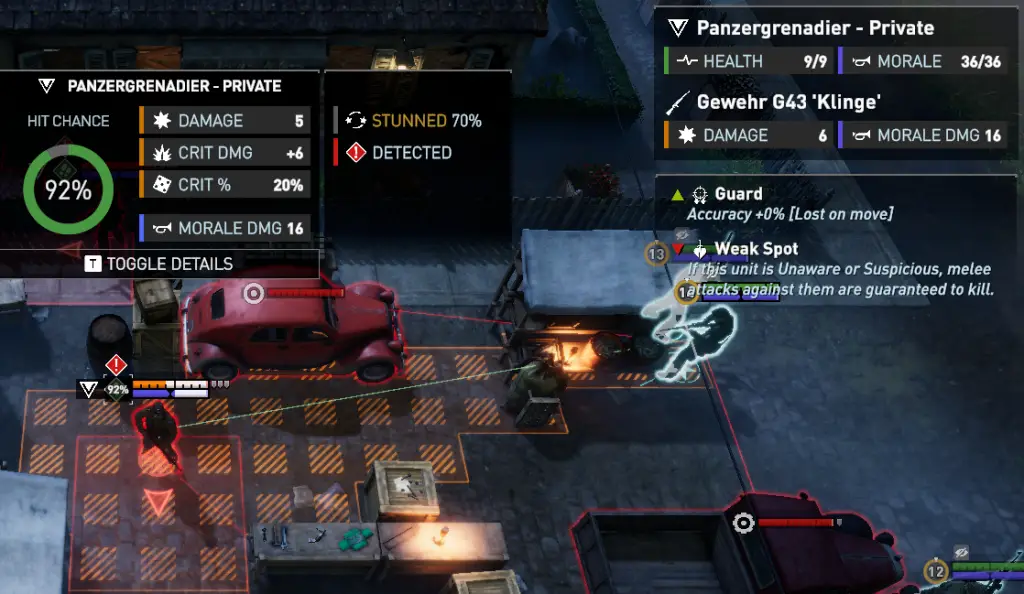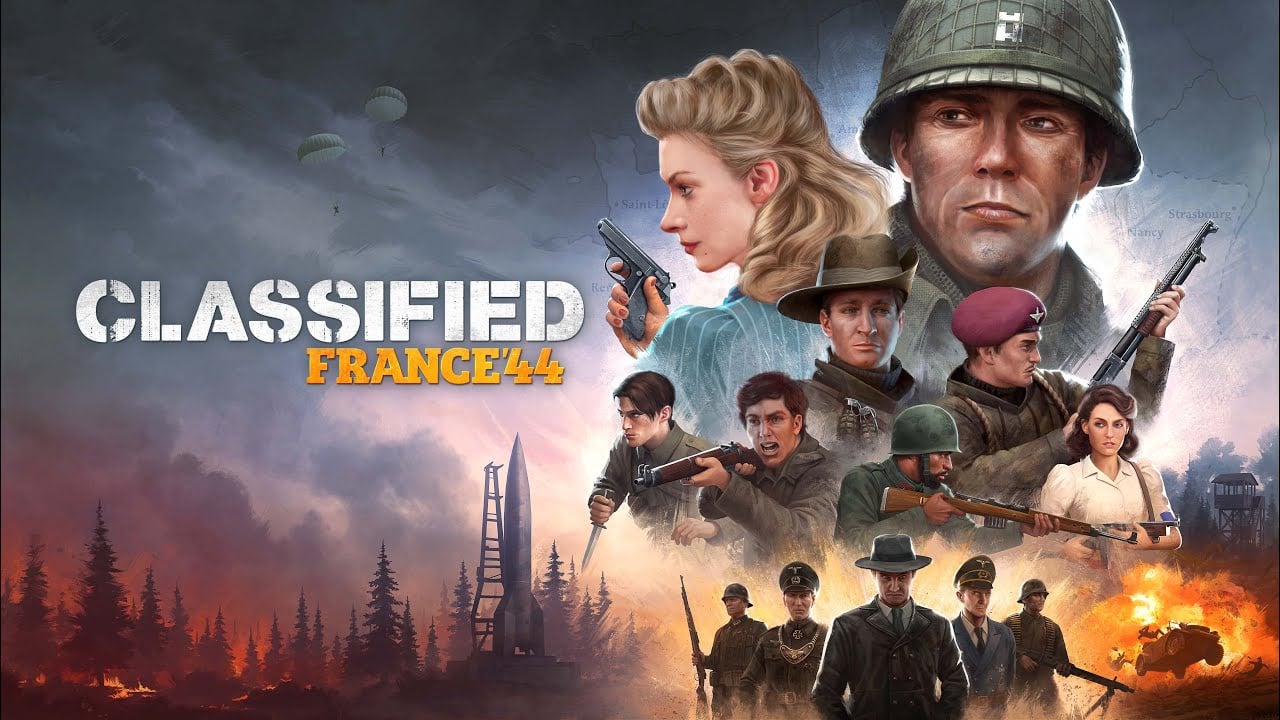Classified: France ‘44 is a turn-based tactical squad game designed by Absolutely Games and published by Team17. It takes place in 1944 in France, in the lead-up to the Battle of Normandy. The player controls a group of commandos responsible for undermining German positions in preparation for the planned invasion.
The Strategy Map

Classified: France ‘44 is played in two main modes: strategic map and tactical battle map. The strategic map is a transitory point where decisions are made about the team, how to spend resources, and which missions to take. All of these are important, but they take much less time than the core of the game, the actual tactical combat.
The game does feature a timer which mostly gives an idea of how many more tactical missions will be played through before the game ends.. Each mission usually takes up exactly 2 days, so half the number of days left shows how many more missions you can get through before the game ends.
Each mission has a difficulty level between one and three, provides a bonus to a relationship with one faction, and gives two or more bonus pieces of gear. Usually, there are at least two missions to choose from, and I have seen this pop up to four at certain points of the game. Many of the missions go away when one of the others is selected, but some are a bit more permanent, and while it may be mandatory to go through them eventually, there is usually a bit of time before this is necessary.
There are a few different types of missions. Normal missions allow for some level of stealth, but once the commandos achieve a number of stealth kills equal to the threshold defined by the mission. Defensive missions generally require the commandos to defend a location and/or people until the time runs out at which point they can evacuate. Stealth missions never force the commandos outside of stealth, and generally have goals that don’t require you to leave stealth.

Each mission also features a specific faction it is associated with and post-mission, the player will increase support in one of the faction’s regions. Once the region is completely controlled, it gives a special power that is retained for the rest of the game… unless they are disrupted. At a certain point in the game, the Nazis roll out countermeasures to the right against the players with a figure that moves around the map, disrupting the resistance networks and increasing the power of enemies in missions in that province. Eventually, resources can be used to stop the counterintelligence squad, but these resources are rare and should be used wisely.

One of the most important things about this is determining how to use tasks. No more than one character can take each of them, and each one requires spending supplies, the primary in-game resource. Training (which gives XP) and Aid Faction (which builds the team’s relationship with one of the three factions) are pretty much always useful, where Repair Region and Cure Regions are useful if things go a little haywire and Retraining is useful if a character’s build is not quite working.

The first tab is the Basecamp, where the commandos can be customized, and post-mission conversations can be heard. This is mostly fluff, but there are some limited mechanical reasons to click over every mission. After each mission, all characters get some fatigue, reducing their available action points until they spend a mission at rest. The two characters who have a conversation get a small permanent bonus to their willpower and have a point of fatigue recovered, making it so they are likely to be able to jump back into a mission at maximum capability immediately.

The second tab is Loadout. This lets you manage your characters weapons, their appearance (which includes both those without mechanical modifiers and without), and their skill points.
Each character class has access to a different primary weapon but shares access to a sidearm pistol, dagger, and grenade. Throughout the game, you will gain access to upgraded versions of weapons in all of these slots, both as mission rewards and through purchasing from factions. Weapons upgrades are usually a mix of increased base stats, but can also include all sorts of secondary benefits up to and including status effect applications with a percentage chance of success. These can be quite powerful, and it is, for example, possible to build a character who combines one of the better status effects (like stun) with an increased chance of success and simply lock enemy characters down.
Character appearance can be modified with a variety of purely cosmetic options, but in the same way you can get upgraded weapons, you can also get upgraded personal gear which buffs stats like armor, health, morale, action points, and various miscellaneous defensive and regeneration stats.

Each character class has its own double-sided tree, and each character has their own unique skill. These are pretty interesting and can provide some sort of direction in how to build a character, but most of what a character can do is driven by their class. Every time your character levels up, they will get a skill point, and a character will typically level up at least once per tactical stage, but sometimes it will be a bit more. These powers are strong and fun, and there is some real decision-making in how and when you unlock them and what specific niche they are going to take.

The last tab is the factions tab. This gives information about the team’s relationship with each faction and gives you access to the gear that they give you access to based on this relationship. These items cost supplies and can get pretty expensive, so there is usually a fair amount of decision-making that needs to be made when purchasing one of these items compared to doing important tasks.
Tactical Battles
While Classified: France ‘44 is very much its own game, it is clearly influenced, as many games are, by the general structure of X-Com 2. It features a system of alternating turns between the commandos and nazis where all of the commandos can be moved, and then all the nazis follow their programmed movement. The commandos start hidden, though once the Nazis spot them or once combat starts, it features a percentage-based hit system, with cover penalizing attack chances and a variety of character-based special abilities. It differs most prominently in its stealth system, morale, weapon’s area of effect, and action points.


Enemy units move in a programmatic way, with some wandering around and others turning or remaining static. Each has a radius of vision, which you are able to see on the map, and a visual indicator about what direction they are going to turn and walk. Characters are able to use their knives to kill enemy troops if they can sneak up behind them.
However, some enemies are too tough to be able to kill with a sneak attack or, like the grenadiers, will blow up if you do so, which limits your options with this tactic somewhat. The unaware indicator further limits this. Once you pass this indicator, all of the commands refresh all their action points, and enemies on the map become aware of the character who triggered the awareness and all of the other units that have been visible at any point.

While most tactical squad systems feature unit hit points, Classified: France ‘44 also features a morale system. When a character on either side loses half of their morale, they lose half of their action points in the following turn. When they reach 0, they are broken and get no action points in their turn. Either of these can be fought against if you use morale restoration abilities from a leader class unit. Still, it is generally a good idea to prevent characters from falling down in the first place, as hitting – morale is one of the two ways that a unit can become injured and thus have reduced stats for future missions until they are healed.
The action point system is about what could be expected from other games that feature action point systems. Movement and special abilities all use up action points, with weapons having varying action point costs based on what weapon they are. Weapon attacks additionally end a character’s turn. However, there are some abilities that modify this, meaning that you have to plan a bit in order to help ensure you are able to maximize the character’s turn prior to ending it.

A lot of weapons feature an area of effect, with the highest chance being on the target of the attack, but some level of chance for other units in the area of effect as well. Allies can also be hit with this attack, so careful care must be taken to ensure they are outside of the area of effect.
Assessment and Conclusion
I enjoyed Classified: France ‘44. It is not something that completely shakes up the genre or stands out for being cutting-edge, but it is fun and shakes up the formula enough to make it a fun and engaging game. It has a good user interface, challenging and interesting stages, and distinct characters, and it is a competent, well-designed package.
My only real complaint is one that I frequently have about turn-based tactical games, which feature character progression. Characters seem to mostly settle into their builds about three-quarters of the way through the game, making it. Hence, future decisions do little more than provide capabilities that are already available with other characters or pump numbers up. This is not a huge problem, and many players prefer to have a bit of time just trying out characters at maximum capabilities, but I am not one of them, and I would have preferred more interesting choices well into the end game.









